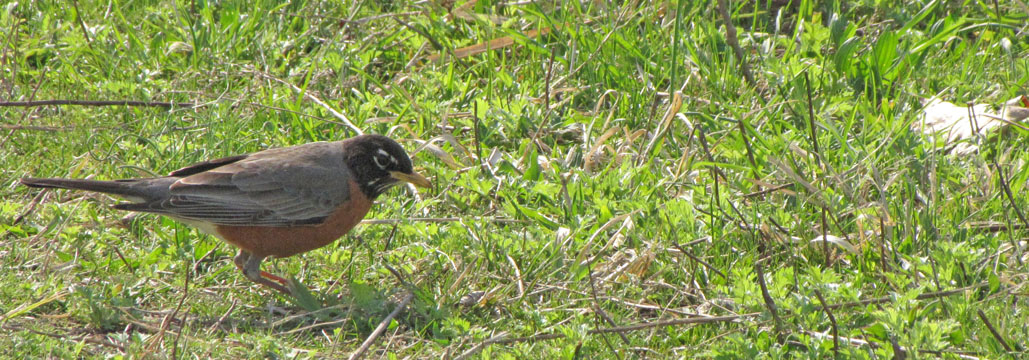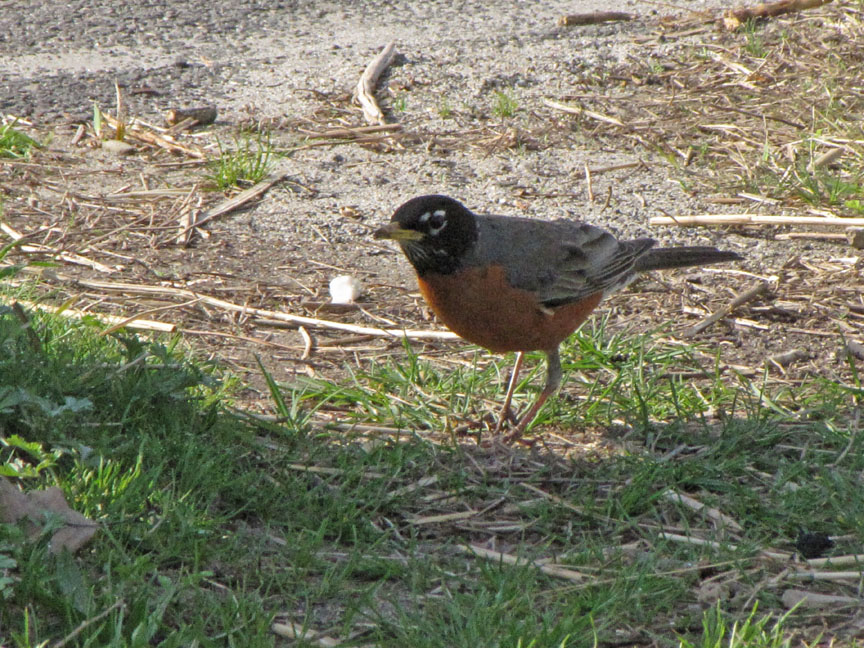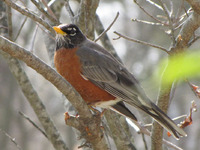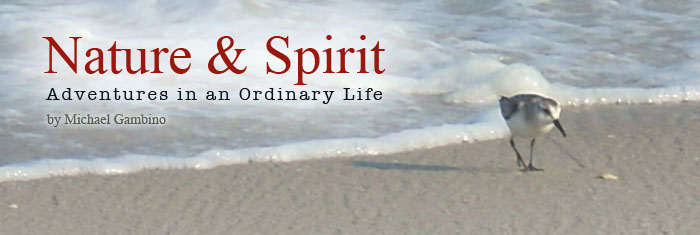Dance of the Robin
 Thursday, April 8, 2010 at 10:47PM
Thursday, April 8, 2010 at 10:47PM It was a few days before spring, before the nor’easter pounded our area saturating every square inch of field and forest. I was standing outside behind the nature center where I work, looking at the low gray clouds sliding greasily overhead. It was quiet – not much in the way of spring bird songs yet. After a moment or two I became aware of some sound that seemed to be at once every where and nowhere. I looked around, initially seeing nothing large that matched the sound I was hearing. A moment later, looking at the landscape with wide-angle vision (a sort of unfocused gazing where a wider field of vision is achieved), I found the source of the sound. A robin was in the dry leaves scratching for insects. Then I became aware all at once that there were more than fifty robins spread out over the surrounding, thinly-wooded landscape, all intently hunting for worms and other insects.

 The sound was amazing, and I stood there in awe of this phenomenon. Each individual bird was busy sorting through the dry grasses and leaves in a random yet harmonious manner. The sound entered not only my ears, but my body as well. I was inside this sound, drawn in and enveloped by this sort of tribal dance of the Robins. Stamping, thumping, clawing, scratching, flicking, hopping, pecking, flipping, and darting. It was simply fantastic!
The sound was amazing, and I stood there in awe of this phenomenon. Each individual bird was busy sorting through the dry grasses and leaves in a random yet harmonious manner. The sound entered not only my ears, but my body as well. I was inside this sound, drawn in and enveloped by this sort of tribal dance of the Robins. Stamping, thumping, clawing, scratching, flicking, hopping, pecking, flipping, and darting. It was simply fantastic!
Beyond the experience that this sensation felt wonderful, I noticed that in some inexplicable way, I was being nourished by the encounter with these dancing robins. I was being fed by nature on every level: my body (the pre-lunch hunger left me, and I felt more relaxed), my mind (relief from too much logistical planning; a shift from left-brained to right-brained activity), spirit (experiencing my connection with the spirit-that-moves-through-all-things), and my emotions (dreariness lifted and replaced with joy and excitement).
The American Robin, a member of the notable Thrush family, is one of the first birds in North America in to lay eggs in early spring. They produce several broods per year, laying between three and five eggs in the classic “Robin’s Egg Blue” color. The nest is a sturdy one constructed of mud, feathers, twigs, bits of paper, dried grass, and lined with softer material. Both parents will feed the chicks, but nest construction is the domain of the female, most likely because she alone sits on it incubating the eggs and so needs a proper fit. It takes two weeks for the eggs to hatch, and the chicks are fledged from the nest in another two weeks. Sometimes “decoy” nests are build to fool any watchful predators like crows and raccoons.
 The American Robin (Click to enlarge).The robin is a handsome bird, and a skillful hunter (though its Latin name, Turdus migratorious is not as impressive). I am completely captivated by their hunting prowess. They are not birds of prey, as are the hawks, but try telling that to the worms! The robin begins his hunt standing motionless; a moment later, a short burst of speed as he runs ahead, then stops abruptly. He tilts his head, then bows smartly towards the ground and pauses; a slight adjustment of aim, then a precise strike with his yellow beak, stabbing at the soil, tugging sharply at his prize: an earthworm. It is hypnotic to watch the Robin do this over and over again.
The American Robin (Click to enlarge).The robin is a handsome bird, and a skillful hunter (though its Latin name, Turdus migratorious is not as impressive). I am completely captivated by their hunting prowess. They are not birds of prey, as are the hawks, but try telling that to the worms! The robin begins his hunt standing motionless; a moment later, a short burst of speed as he runs ahead, then stops abruptly. He tilts his head, then bows smartly towards the ground and pauses; a slight adjustment of aim, then a precise strike with his yellow beak, stabbing at the soil, tugging sharply at his prize: an earthworm. It is hypnotic to watch the Robin do this over and over again.
If the robin eats worm after worm upon capturing them, there may not be any young to feed, but if the bird grabs a worm and flies away, it is most likely feeding nestlings. If you can follow the flight path of the bird, you may soon discover its nest site (usually not more than fifteen feet above the ground in an evergreen tree, dense shrub, or a forked tree. In a few moments, the bird will probably head out again to continue hunting. See if the pattern is repeated a few more times to confirm the nest location. I have often observed some robins grabbing a new worm with previous victims crammed and wriggling in its beak.
The female’s coloring is a slightly muted version of the male’s famous orange or rusty red breast. Both sexes have a black and charcoal gray back and head with a white eye ring. The beak is a pronounced yellow. These descriptions of their markings are only the most obvious ones. If you take the time to really look at a robin for more than a casual glance, you’ll see the bird is sporting subtle detail and coloring that help it blend in with the tree bark and dried leaves. I always enjoy the robin’s unmistakable and cheerful song as it penetrates the cool mists of dawn and the hazy gray of twilight.


Reader Comments